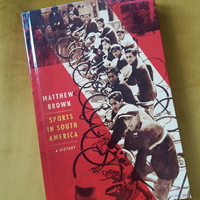
Nathan Cardon
I began my career as a historian of the nineteenth century U.S. South. Since the completion of my first book project in 2018, I have shifted my attention to national and global histories of technology and mobility within the field of U.S. foreign relations. Ultimately, my research explores the cultural dynamics of race and empire in the shaping of American modernity across the nineteenth and twentieth centuries.
A Dream of the Future: Race, Empire and Modernity at the Atlanta and Nashville World’s Fairs (Oxford University Press, 2018).
My first book considered the ways white and Black southerners promoted their region in an age of empire. In the late nineteenth century, southerners mobilized the Atlanta and Nashville world’s fairs to challenge popular images of the region as backward and agrarian. In doing so, they presented their own image of what a future and imperial South could be. Significantly, the Atlanta and Nashville fairs featured Black-run exhibits to which clerical and professional members of the local and national community rallied as a way to both challenge and accommodate Jim Crow. A chapter of the book was first published in the Journal of Southern History as “The South’s ‘New Negroes’ and African American Visions of Progress at the Atlanta and Nashville International Expositions, 1895-1897” (2014).
In 2017, I published an article on convict labour in Louisiana following the Civil War in Louisiana History. “‘Less Than Mayhem’: Louisiana’s Convict Lease, 1865-1901” has been cited not only in the new histories of the carceral state but has informed work on the health of Louisiana’s contemporary prison population.
The World Awheel: Americans in the First Global Bicycle Age, 1885-1920 (Columbia University Press).
My current research addresses contemporary needs for a fuller and wider understanding of the historical relationship between active mobility and the politics that shape our lives. Situating the first U.S. bicycle boom within a global framework, it reveals the ways in which inequalities rooted in empire were not separate from but mutually constitutive of American technology and culture. The World Awheel argues that the bicycle and its social and cultural worlds provide us with a grounded way to understand Americans’ experience and understanding of the world at the very moment the nation shifted from a continental settler empire to an overseas and imperial one. It highlights the ways that Americans understood themselves as in this world and the ways that the forces of empire both produced and influenced these outlooks at the exact juncture of the local, national, and global. With mass automobility in the United States only taking off after the First World War, the book asks how the bicycle—the most significant global technology of personal mobility during the key decades of the United States’ rise as an industrial and imperial power—influenced and shaped Americans’ experience and understanding of the world.
I have published three articles related to the current book project that bridge my past and current research. “Cycling on the Color Line: Race, Technology, and Bicycle Mobilities in the Early Jim Crow South, 1887-1905” was published in Technology & Culture (2021). It argues that historians must look at technological solidification from the perspective of race to fully understand its social and cultural articulations. “Global Mass Culture, Mobile Subjectivities, and the Southern Landscape: The Bicycle in the New South, 1887-1920,” in the Journal of American Studies (2022) contends that the history of the bicycle in the New South can better reveal the ways the region was embedded in and not separated from the world at the end of the nineteenth century. A co-authored article in the Journal of Sport History follows the emergence and elaboration of cycling as a global sporting culture, casting light on how the sport was experienced across and between spaces that challenge notions of coherent “nationality and territoriality” in the crucial decade before the First World War.
I have published in The Washington Post’s “Made by History” series on the legacies of Jim Crow on mobility (2021); used an artefact from Birmingham’s Science and Technology Museum to write an accessible history of technological adaptation that highlights the city’s deep connection to the British Empire (2023); and mobilised an archive of unpublished photographs to explore Black mobility, childhood, and joy for Black Perspectives (2023). In 2024, I partnered with the BMT’s curator of science and technology on an AHRC impact fund to produce people-focussed histories of mobility that offers a roadmap for a sustainable future. The project resulted in a small exhibition accompanied by an accessible talk on the history of the bicycle in Birmingham and its future potential.
A Dream of the Future: Race, Empire and Modernity at the Atlanta and Nashville World’s Fairs (Oxford University Press, 2018).
My first book considered the ways white and Black southerners promoted their region in an age of empire. In the late nineteenth century, southerners mobilized the Atlanta and Nashville world’s fairs to challenge popular images of the region as backward and agrarian. In doing so, they presented their own image of what a future and imperial South could be. Significantly, the Atlanta and Nashville fairs featured Black-run exhibits to which clerical and professional members of the local and national community rallied as a way to both challenge and accommodate Jim Crow. A chapter of the book was first published in the Journal of Southern History as “The South’s ‘New Negroes’ and African American Visions of Progress at the Atlanta and Nashville International Expositions, 1895-1897” (2014).
In 2017, I published an article on convict labour in Louisiana following the Civil War in Louisiana History. “‘Less Than Mayhem’: Louisiana’s Convict Lease, 1865-1901” has been cited not only in the new histories of the carceral state but has informed work on the health of Louisiana’s contemporary prison population.
The World Awheel: Americans in the First Global Bicycle Age, 1885-1920 (Columbia University Press).
My current research addresses contemporary needs for a fuller and wider understanding of the historical relationship between active mobility and the politics that shape our lives. Situating the first U.S. bicycle boom within a global framework, it reveals the ways in which inequalities rooted in empire were not separate from but mutually constitutive of American technology and culture. The World Awheel argues that the bicycle and its social and cultural worlds provide us with a grounded way to understand Americans’ experience and understanding of the world at the very moment the nation shifted from a continental settler empire to an overseas and imperial one. It highlights the ways that Americans understood themselves as in this world and the ways that the forces of empire both produced and influenced these outlooks at the exact juncture of the local, national, and global. With mass automobility in the United States only taking off after the First World War, the book asks how the bicycle—the most significant global technology of personal mobility during the key decades of the United States’ rise as an industrial and imperial power—influenced and shaped Americans’ experience and understanding of the world.
I have published three articles related to the current book project that bridge my past and current research. “Cycling on the Color Line: Race, Technology, and Bicycle Mobilities in the Early Jim Crow South, 1887-1905” was published in Technology & Culture (2021). It argues that historians must look at technological solidification from the perspective of race to fully understand its social and cultural articulations. “Global Mass Culture, Mobile Subjectivities, and the Southern Landscape: The Bicycle in the New South, 1887-1920,” in the Journal of American Studies (2022) contends that the history of the bicycle in the New South can better reveal the ways the region was embedded in and not separated from the world at the end of the nineteenth century. A co-authored article in the Journal of Sport History follows the emergence and elaboration of cycling as a global sporting culture, casting light on how the sport was experienced across and between spaces that challenge notions of coherent “nationality and territoriality” in the crucial decade before the First World War.
I have published in The Washington Post’s “Made by History” series on the legacies of Jim Crow on mobility (2021); used an artefact from Birmingham’s Science and Technology Museum to write an accessible history of technological adaptation that highlights the city’s deep connection to the British Empire (2023); and mobilised an archive of unpublished photographs to explore Black mobility, childhood, and joy for Black Perspectives (2023). In 2024, I partnered with the BMT’s curator of science and technology on an AHRC impact fund to produce people-focussed histories of mobility that offers a roadmap for a sustainable future. The project resulted in a small exhibition accompanied by an accessible talk on the history of the bicycle in Birmingham and its future potential.
less
Related Authors
Anuario Colombiano de Historia Social y de la Cultura
Universidad Nacional de Colombia (National University of Colombia)
Matthew Brown
University of Bristol
Harald Fischer-Tiné
Swiss Federal Institute of Technology (ETH)
James Stout
University of California, San Diego
Ofri Ilany
The Van Leer Jerusalem Institute
Peter Cox
University of Chester
InterestsView All (28)










Uploads
Books by Nathan Cardon
Peer-Reviewed Articles by Nathan Cardon
Other Writing by Nathan Cardon
Papers by Nathan Cardon